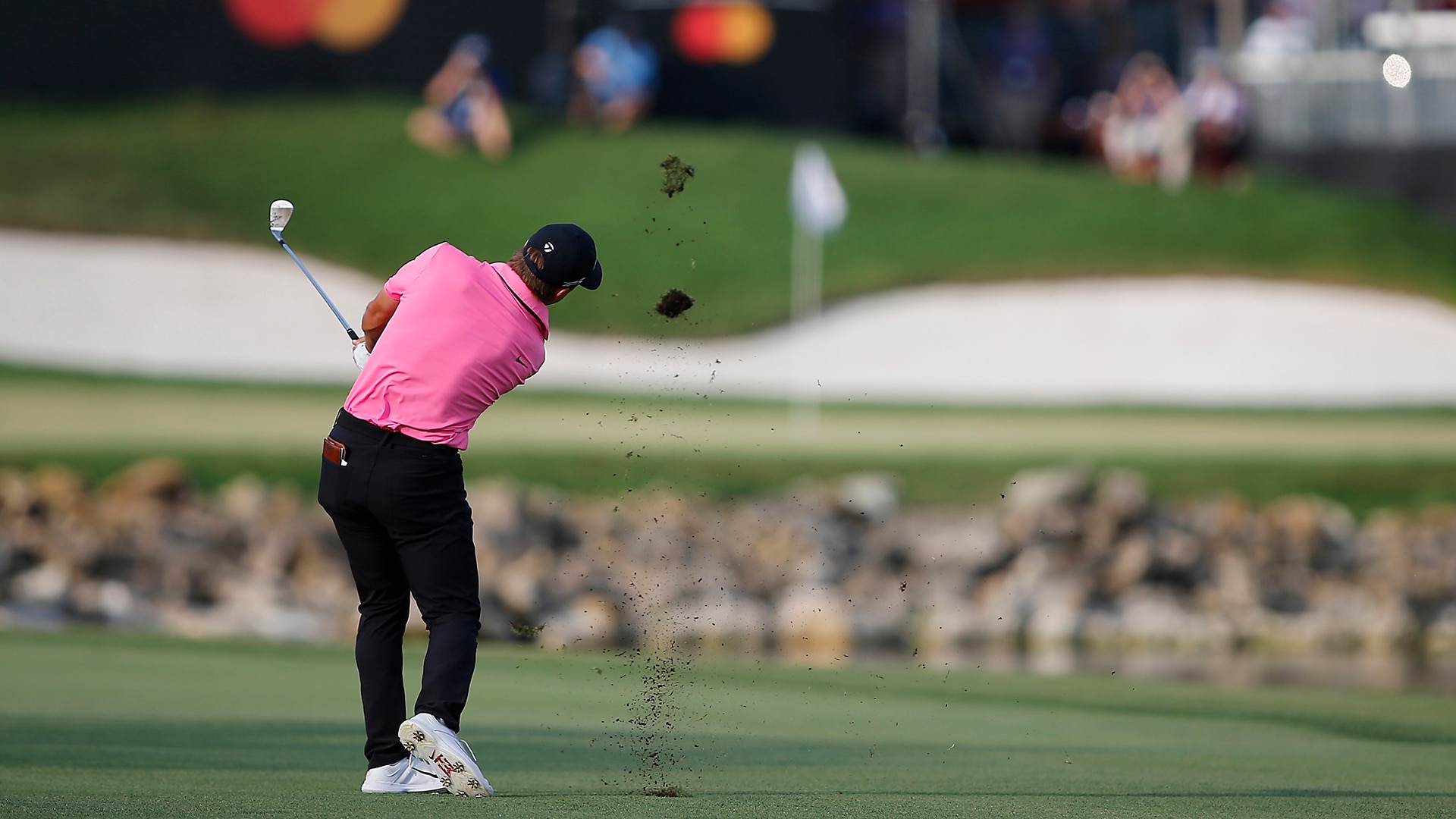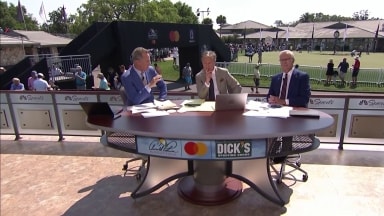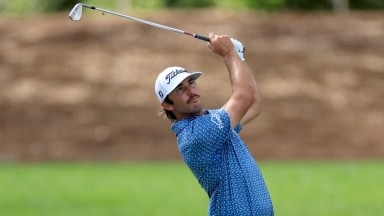The big 5-0: Questions remain as battle underway for spots in ’24 designated events

ORLANDO, Fla. – Are these designated events fun or what?
Scottie Scheffler pulling away from a red-hot Jon Rahm and successfully defending in Phoenix.
Rahm outdueling Max Homa at Riviera.
And Kurt Kitayama holding off a throng of superstars, from Scheffler to Rory McIlroy to Jordan Spieth, at Bay Hill.
That was all in the past month.
“I think they have all been pretty successful so far, and they have definitely been a lot of fun to play in,” Scheffler said. “Hopefully, they have been fun for the fans to enjoy as well. Hopefully, we’re moving in the right direction. I certainly believe that.”
Of course, the PGA Tour also began to roll out details for next year’s designated event model, highlighted by what could be as many as eight limited-field, no-cut tournaments. There are multiple avenues to qualify for these 70- to 80-man events, which will also feature huge purses and elevated FedExCup points.
Here is the good:
• Ensures that the PGA Tour’s stars play together more often.
• Clearly distinguishes the big events from the other events, whether it’s via field quality or amount of points/money up for grabs.
• Creates more storylines within a tournament as players try to play their way into the designated fields.
But while many players view the changes as an overall win, that doesn’t mean there aren’t a few concerns or questions. Here are a few of them:
How tough will it be to get into the elevated events?
The buzzword this past week was “churn.”
With as many as eight events now moving to limited fields with no cuts, and increased FedExCup points distribution for those elevated tournaments plus the four majors, The Players and three playoff events, it’s easy to envision something resembling a closed-shop scenario where it’s hard for many players to play their way into – and out of – those lucrative events.
Speaking to Golfweek’s Adam Schupak, Peter Malnati, a member of the Player Advisory Council, admits he was initially skeptical that there would, in fact, be significant churn. But when presented with data, Malnati was informed that over a thousand simulations put the number between 14 and 22 players in the FedExCup top 50 being replaced year after year.
“I wouldn’t have thought that,” Malnati said.
Though he still conceded, “It seems kind of hard to believe.”
To compare, the 2017-18 and 2018-19 seasons – the last time the PGA Tour had two consecutive seasons uninterrupted by a pandemic or LIV defections – saw 21 players finish in the FedExCup top 50 in 2018-19 who didn’t crack that number the previous season.
Players such as Rory McIlroy will note, “You play well for two or three weeks, you’re in a designated event. You know then if you keep playing well you stay in them.” That is all true, but is it as simple as it sounds?
Having 15 of the 70 or so spots open to players via either the current FedExCup standings or performances in preceding clusters of non-designated events is a positive. This creates other intriguing reasons to watch these non-designated events other than just being introduced to potential future stars.
But are the opportunities bountiful enough? Would increasing the field sizes with a dozen more of these qualifiers make the product better?
Will it be the same 10 guys getting into designated events via the current FedExCup standings because they play well early in the season and pad their points?
Would a per-event allotment of designated-event invites be better than an aggregate system, so that players gunning for designated fields don’t feel like they need to play every week like a lot of them did on the Korn Ferry Tour?
And if 50 players are already guaranteed points in at least eight limited fields (plus likely all the majors and The Players), how many other guys, realistically, can break their way into the designated events by playing the lower of what one player called “two separate tours?”
“You’re going to have to win or play unbelievable to get into the designated events [via the top 50] just because a lot of them will have increased points,” said David Lipsky, who finished 89th in last year’s FedExCup standings and is currently 71st. “Hopefully, they come up with a system that makes it a little more equitable for other players because as of now it looks like they’re just going to take care of the top guys. Obviously, those guys play well, that’s why they’re up there. But it’s going to be a grind to get up there.”
Currently, most PGA Tour events award 500 FedExCup points to the winner, with designated events handing out 550, and 600 points going to players who win a major or The Players. And players seem to all agree that not all events are created equal, and therefore FedExCup points should be better allotted as such.
“I think that’s going to happen, and I think it should happen,” said rookie Ben Griffin, currently 37th in FedExCup points. “Someone who finished third here [at API] should probably be rewarded more than a winner in Puerto Rico.”
But as Griffin points out, there needs to be a fine line: Designated events can’t award too many points, and there can’t be too many of those tournaments. Otherwise, the chasm between the stars and everyone else could be impossible for more than a handful to overcome each season.
“It definitely is very rewarding to play good golf based on these changes,” Griffin added. “There’s an opportunity to make a lot of money and compete against the top players in the world more often. From that aspect, I think it will be good. What I personally think, from a rookie standpoint, is guys coming on to the Tour, it makes it a little more difficult. I don’t know if the changes were really necessary. I feel like the Tour was actually in a good spot.”
Are no-cut, 70-player events really the way to go?
Lipsky was two shots below the eventual cut line Friday afternoon at Bay Hill, and an early trip via I-4 and I-95 up to Ponte Vedra Beach, Florida, was certainly in the cards. But that was before Lipsky birdied three of his final five holes to make the weekend by two.
“It’s funny,” Lipsky said. “I was telling my caddie … that feeling of accomplishment to make that cut, especially late in the round, I’m not sure you’ll get that same feeling or be able to emulate it in any way in no-cut events.”
When the first details of the Tour’s restructured designated events model surfaced last week, one of the main criticisms was the lack of a cut. Many of those critics pointed to the waning interest in the now-defunct WGCs, which didn’t feature 36-hole cuts and on at least one occasion had an injured player bunting a drive off the first tee before withdrawing just to collect a paycheck. Some also noted two years of the Tour’s star players speaking out against LIV’s no-cut model and how it doesn’t stack up with the Tour’s legacy of meritocracy. Now, no cuts were good?
Mac Hughes, 57th in last year’s FedExCup, admits he didn’t see the need for these types of designated formats. But he eventually changed his tune.
“The kneejerk reaction is no-cut events are trying to be like LIV, but you have to qualify your way in. … and the majority of our tour has events with a 36-hole cut, and they’re all still merit based,” Hughes said. “We’re taking a small portion of the schedule and rewarding those top guys, but it’s not like we’ve taken the entire 47-event schedule and made them all elevated events with 70-man fields.”
Looking at the designated events in a vacuum, do the benefits of a cut outweigh the drawbacks? The recent argument for eliminating the cut at these elite events was to ensure that fans showing up to tournaments on the weekend would be guaranteed to see their favorite players.
But how many people are showing up at 7:30 a.m. Saturday to watch anyone other than Tiger Woods if that player is 15 shots back? And are the megastars really missing many cuts in the first place? Not many, and no.
The Masters typically draws a field just under 100 players before cutting to the top 50 and ties. Every player tees off No. 1 and in twosomes on the weekend. If designated events cut from 70 to that number, you’d be sending home few superstars in the first place.
Another aspect of 70-player fields is the potential lack of competition, as some players argue that taking away a few dozen players who could potentially win or contend will lead to more runaway victories.
Before Abraham Ancer won a playoff at the final edition of the WGC invitational that spent much of its existence in Ohio before moving to Memphis, the previous four winners all won by at least three shots. Two of the three Zozo Championships were won by at least three.
“You look at what happened at Riviera and Waste Management, elevated events with full fields, and they turned out amazing,” Griffin said. “Really good duels down the stretch. There were a lot of exciting finishes, and I feel like those happen because there are bigger fields and more opportunities for there to be a closer finish. Even go back to AmEx, if Davis Thompson is not in that field, you never have that duel down the stretch and Jon Rahm wins that tournament by a few.
“So, I think with these elevated events, you’re potentially going to see less duels and more breakaway wins because they’re smaller fields.”
At first, Max Homa thought 70 players “sounded like not enough.” But he was ultimately convinced that the smaller designated fields will actually benefit the non-designated fields. This year, with full designated fields, has been a good case study, with events like the Honda Classic delivering the worst field in its history.
Now, imagine events like the Honda drawing every player ranked Nos. 51 and beyond, instead of just most of them – names that as of the current FedExCup standings include Sam Burns, Justin Thomas and Will Zalatoris, but would most likely be up-and-comers such as Justin Suh, Will Gordon and Nick Hardy.
And the Neal Lancasters of the world (take a quick look at the PR Open field); those are the types that would, rightfully, have their playing opportunities taken away.
“If we made these fields very large in these designated events, it would ruin non-designated events that have been staples of the PGA Tour, that go to cities that people love watching these events with their families,” Homa said. “It would ruin them. No one would play in half of them because it would no longer fit your schedule by any means. … If you make it a hundred [players], these other events are going to struggle and then potentially go away.”
Added Hughes: “And guys still have their favorite courses they’re going to go to no matter what.”
Is this unfair to the non-stars?
For the superstars, it’s tough to complain. Guaranteed paydays. Large purses. Fewer players to beat for those purses.
And for the PGA Tour’s rank-and-file members, it certainly gives them something to aim for.
“I think it’s a good thing,” said Robby Shelton, a former standout at Alabama who has bounced on and off the Tour. “I just need to play a little better and I can keep myself in the top 50. You’re always trying to win, always trying to get better and trying to improve. Sometimes you can get into a lull, so having more of a goal, I like it.”
Added Lipsky: “Obviously, if you get in, the difference is night and day, and it just motivates me to play better and to really keep working on my game.”
But let Griffin play devil’s advocate for a second: “If I wasn’t on the Tour, it’s definitely difficult to process just how hard that task might be to get to the top.”
Next year’s designated model is not open to anyone who does not hold a PGA Tour card, with the exception being a non-member somehow getting a handful of consecutive sponsor exemptions and going off. Why this is important is consider this week: Pierceson Coody, the former top-ranked amateur who has already won twice in less than a year on the Korn Ferry Tour, received an exemption, shot 6-under 66 in the third round and eventually finished T-14.
If this were next year, Coody wouldn’t have been able to play as invites can only be given to Tour members.
“It’s going to be tough,” Coody said. “Coming off the Korn Ferry, I have no idea what that means for me out here. I have no idea how hard it’s going to be to jump from regular to elevated events.”
With KFT grads and the top-ranked player in PGA Tour University likely not being initially eligible for the Tour’s designated events upon arriving on Tour, it only delays the ascension of promising stars like Coody or Ludvig Aberg, who also made the API cut.
Because of all that, Griffin wonders aloud if we could see more of the best players not in designated fields jump to LIV Golf rather than work their way up what is now an even longer ladder.
But Griffin also is among those who note that the non-designated life isn’t exactly roughing it. The purses for these events are still expected to be in the $8-9 million range.
“So, it’s not like we’re playing for peanuts,” added Lipsky.
And there will be fewer Rahms and McIlroys to beat to obtain the winner’s shares of these purses.
“I was talking with a player last week who in this exact moment is not in these designated events,” Homa said. “He had mentioned how it was nice playing the Honda knowing that Jon Rahm is not there. That is a nice feeling right now. If Jon Rahm wasn’t there in L.A., I would have clipped off my second one there and I would be a happy, happy man.”
Now, will every Tour member be similarly pleased when the Tour schedule flips into 2024? It’s likely a question that can only be answered once it all plays out.
“Good golf takes care of a lot,” rookie Kyle Westmoreland said, before adding with a smile, “It’s a great year to finish in the top 50.”
That could be telling.


